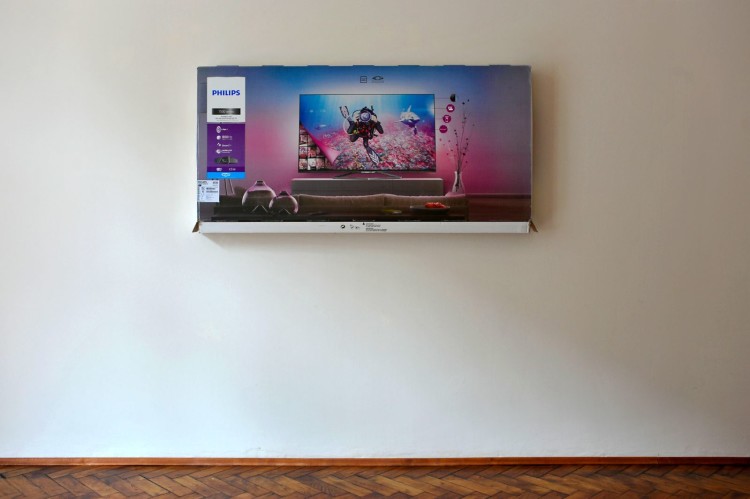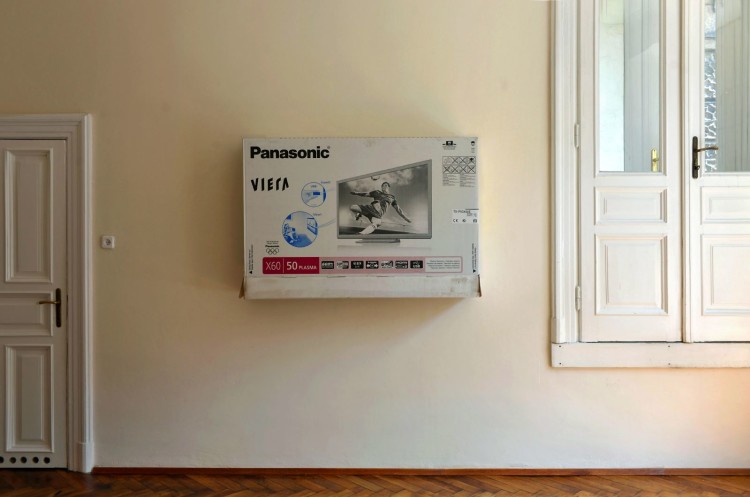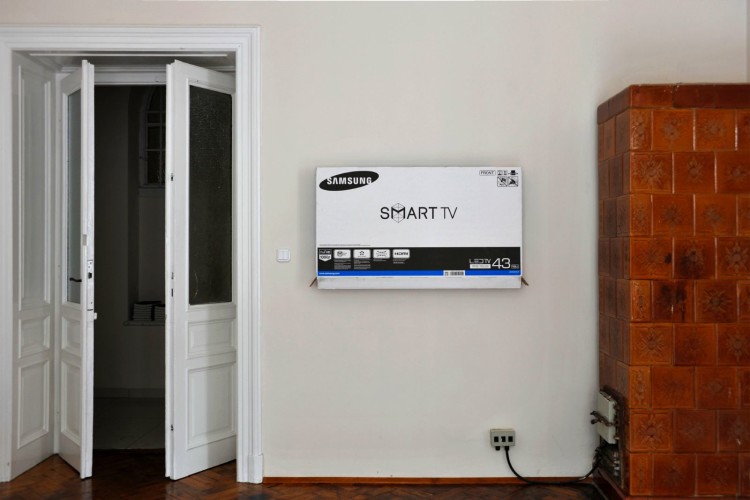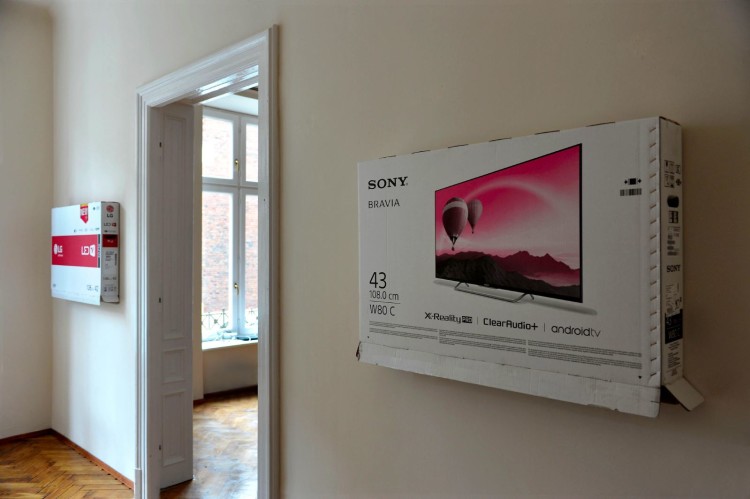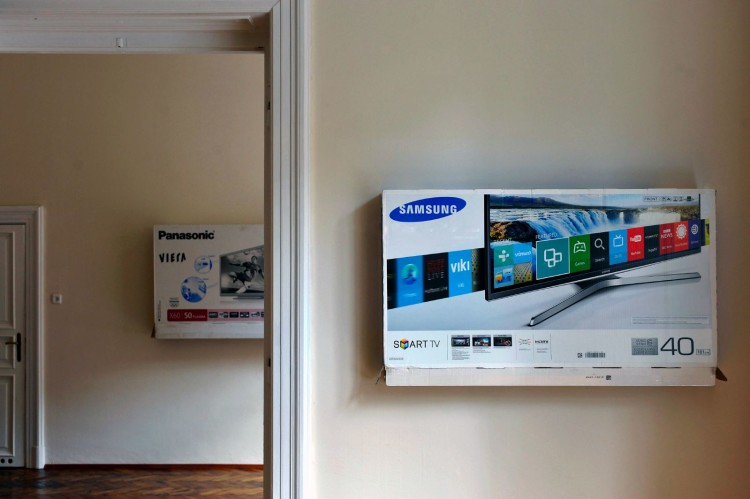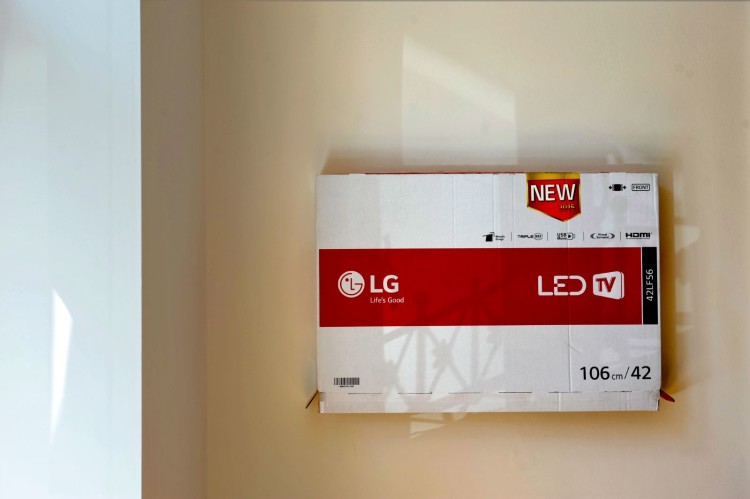content
Secessions and Broadcast, Łukasz Trzciński talks to Piotr Bujak
It seems to me that perhaps it is not the world of art that is bog-standard, but the whole world around us, which worries me rather than wearing out.
SECESSIONS AND BROADCASTS
Piotr Bujak talks to Łukasz Trzciński
Piotr, you say that your exhibition is a sort of homage to Gene Youngblood…
Yes, this is how I see it, up to a point… The title Secession from the Broadcast is a reference to a cycle of lectures by Youngblood on the significance of the media and communication means in the post-internet era. What I find interesting, however, are generally questions related to contemporary consumerism, bourgeois culture and pathologies that can be observed where these two – in their broadest possible sense – meet. Empty boxes that used to protect TV sets, intentionally suspended at the height of 160 cm (I guess, I can’t remember the actual height but it must have been more or less like this), the standard height for exhibitions in art galleries, museums or other profiteering institutions, in a classic bourgeois interior in Krakow are nothing but (this is how I see this at least) a derisive squeal in a punkish/highbrow style, commenting on social engineering or formatting behaviour, rather than some meaningless message about free media.
His ideas anticipating the revolution of free media as we know them today, based on multitudes of amateurs, couldn’t get through American consumerism. Do you believe his theories can be fully transferred into our experience? The content of the term ‘state media’ in the US was rather different from what was streamed from the screen to Eastern Europe and how it was done. Can the idea of ‘audience nation’ be applied to us as well?
Youngblood referred to the crisis of dominant neoliberal democracies, the infrastructure that underlies them and its consequences. I think that ‘we’, in a broad sense of the word, can very much be seen as an ‘audience nation’. Also, the term ‘state media’ – as you’ve said – is rather wide but Youngblood clearly stresses that “all media are state media” and he uses these words in a very topical context. Anyway, I was interested in the problem of critical attitude towards the contemporary mass media as well as the contemporary world, which is largely created by those media.
As I look through your simple black-and-white zine that accompanied the exhibition, copied at the cheapest Xerox kiosk in the city, the only guide to the show, I keep hearing these comments that you should have chosen a better sort of paper or printed it in colour… And indeed, a Xerox-copied binder looks as though… it were out of the world of art! In this strange country, where what counts in the end is a nice intriguing object rather than powerful content, you seem to care only for the latter! It takes just one look at the fragments you fished out with great precision to understand that the zero form hides a pretty weighty manifesto…
And that was the point… I certainly prefer easily multiplied and cheap means of expression. Besides, why make a colour zine on nice paper without giving it some meaning? The packaging must wear away, unlike – to some extent – the packaging of a TV set. I could see no rational justification for another form. Anyway, why don’t we leave aesthetization of this type of actions to bourgeois fascists?
Already on the first page we get to read about ‘secession from dominant culture’ and ‘social control’. As a matter of fact, I am more interested in this area – liberation from streaming control than media-related discussions. I see here a reference to Agamben’s concept of fragmented communities taking shape before our very eyes, the end of an era of the hegemony of great parties, interest groups, mainstream ideologies… What does the idea of broadcast mean to you? It seems to me that we are dealing here with a substantial gap, even though we’re looking at it through the prism of a specific distributor of content, television.
You’re dead right – like in ‘secession from the broadcast’, what I am interested in the most is the problem of formatting. On the basic level, broadcast is for me the whole sphere of communication, founded on direct and relatively easy (although this is a bit tricky) access to information, a deluge of it and the consequences of this situation. But the gap in the unidirectional way of distribution and perception of content is actually a revaluation of the social format/construct as we know and see it today. I mean not only distribution of content but, first of all, social engineering…
I can very much relate to your consistent attitude – in a patriarchal society with a long-established set of values, you walk the streets wearing floral leggings, you don’t drink, you work with objects that simply do not fit into the circulation of the world of art, you slip away like those flat screens that fell out / slipped from the boxes… You intentionally position yourself on the margin of the system of distribution of art objects (or, in the case of Poland, an imaginary picture of it) as you focus entirely on content. Powerful ideas may also come in nice and intriguing packaging to attract buyers; it is surprising for how many of our friends with whom we communicate very well on the intellectual level this is an unconditioned response. Is this, to put it delicately – weariness of the still very much bog-standard nature of the world of art? Your work is being increasingly described as ‘axe-chopped conceptualism’…
I am very fond of this phrase… ‘axe conceptualism’. Well, I’m really interested in the production of content rather than profiteering. What Secession from the Broadcast is chiefly about, I guess, is the fact that packaging is a helluva potent instrument of manipulation. I know this is a cliché but I still think we should be talking about this till we get sick. Then again, I’m not that skeptical when it comes to ‘nice and intriguing’ packaging. But it is the content that I care about. It seems to me that perhaps it is not the world of art that is bog-standard, but the whole world around us, which worries me rather than wearing out. This worrying, lack of unconditional acceptance or the willingness to understand the causes of this state of affairs are what my artistic practice is founded on. My favourite fields are minimalism, post-conceptualism and, perhaps, situationalism; I’m trying to find new raw solutions for them, taking synthetic decisions and making simple gestures, but these are but tools, I don’t intent to use them forever. On the other hand, these decisions/gestures are made responsibly, and my works are formally complete (or at least I believe they are – perhaps I’m exaggerating), so I guess they can also be seen as bog-standard… That depends, I suppose, on how you define ‘bog-standard’ in a given context.
A medium that has so far relied on unidirectional distribution of content, on programming an ‘audience nation’ as Youngblood and others put it, seems to turn the screen into a white board. Streaming, control over the media are becoming pointless. Gene doesn’t need to worry, amateurs, whom he has such a high opinion of, seem to rule the sphere of communication.
The division into state and private media is no longer that important because everyone can operate messages. Is this really so? Do you believe that freed television can be the zero medium these days, like McLuhan’s white light? Because it carries no message anymore, it is no longer the medium of communication policy? Is this so? Who is behind the light today? Or perhaps, whose attitude does it reflect? When those who have so far been viewers become distributors, do the media yield to spontaneous loops of messages?
The fact that multitudes of amateurs can easily create messages and distribute them on an unprecedented scale is obvious. I am not sure, however, whether this means that have the power to control the message. The power tends to be exercised by those in power, if I may say so. Just as I said before, quoting Youngblood, “all media are state media”, which is something we cannot afford to forget about.
The fact that streaming has become dispersed doesn’t automatically mean that today’s version of television is the zero medium. Media are not free; perhaps they have greater potential of being more accessible. Viewers don’t really distribute content, they merely redistribute it, which may, of course, lead directly to looped messages, but this is exactly what I am interested in – contemporary communicational predicament. I think we could say that there is always capital/power/politics behind broadband streaming, but today other types of streaming make it possible for amateurs to control them. Broadcast should actually be interpreted through the prism of all channels through which contemporary messages as well as the echoes of past ones are forced. So the whole circulation of goods with all side strains, architecture, official and nonofficial, growing into the urban fabric, or the looping in the communication between the sender and the recipient, we should really conclude that… the society itself is broadcast!
That’s right, so far ‘broadcasting’ has had to use a ‘common language’ – copy, repeat, imitate the language and range of knowledge of an average viewer to reach as many of them as possible. So it was repetitive in order to be successful. Another quote from Agamben comes to my mind, it goes more or less like this: contemporary reality is nothing more than an advertisement with all the traces of the advertised product removed. You cannot generate a potentially objective image of the world because, in most cases, it is an echo of other representations, an artificial creation. Images of natural disasters seem fairly natural, while wars, no matter where they are waged, are a never-ending movie… The social character of distribution has turned out to be based on a system of clichés…
You’re right – media not only use a common language, they create it to a large extent. They are repetitive, the message is looped, a parallel reality. There is very little space for creation because one has to stick to established formats to satisfy the audience. It is hard work for the media to hack this looping and introduce a virus / new content. The fact that you’re not capable of generating a potentially objective image of the world doesn’t mean that you can stop trying. The image, the advertisement must be hacked, in all possible ways.
Going back to the exhibition, I am under the impression that the material has somehow escaped from what we initially intended, or to put it more directly – it got one step ahead of us. We wanted empty TV packaging, taken out of its usual context, suspended in an art gallery to allude to the theory of commodity fetishism, to the idea that an object/product accumulates a range of strategies in itself, it is their result. Accumulation of content, a construct to be broken down to its constituent parts. But nothing had to be broken down because the boxes that had contained screens, which you had found/chosen, turned out to be totally critical towards the medium they stood for.
The way content is constructed by the companies that govern it is a direct comment of the erosion of the medium in its recent form. Message by which packaging is to reach the audience clearly indicate the end of distribution of content as we know it; it has become almost completely marginalized. We see a serious message, and while we think of the langue – we could as well be reading a cartoon version of Youngblood…
At the same time, the fact that technological evolution in fact decentralizes current authorities is important. Ongoing dematerialization of what has been its attributes so far, including the media, results in its progressing democratization, developing of communities, which fortunately makes the whole process irreversible. At the same time, as you’ve said, this secession has not been brought about by the masses. It is the medium itself that gives up. Like in the dominant social construct. I mean that now is the moment when the established form of social order can be overthrown and this is beginning to happen. When the hegemony of molochs, dominating streamings is wobbling.
From my perspective, it is also important that the future revolution was not anticipated by a theoretician but a full-blooded media practitioner. Youngblood could develop his theories because he’d been a broadcast practitioner himself, as a journalist he’d participated in the formatting of content and its distribution. As an insider, he could observe the workings of the system and reach conclusions determining potential paths for the future. Today, when almost all of us are ‘from the inside of the medium’ as individual content distributors, do you think that there might critical potential somewhere in these masses able to foresee further evolution? Has broadcast really become collective? What do we need to consciously watch this from a distance?
There is always critical potential in the masses but there’s also always the risk that this potential can be channelled into something dangerous. Video blogs, Facebook and similar instruments of message flow/flows, regardless of their good points, are just a way of controlling and gathering information about their members in the end. I am sure that further evolution or further evolutions have already been foreseen and to be able to watch them consciously from a distance, or furtively at least, we should engage in more activities like ours and popularize them as good as we can.
Anyway, it seems to me that the Polish language doesn’t have a term broad enough to reflect the American broadcast. I can’t think of a word that would contain the ‘cast’ part, formatting.
Similarly, the Polish word ‘władza’ fails to communicate the temperature of the English ‘power’…
The native language is the first format we’re forced into. We are shaped by its temperature, tension, melody, not to mention its limitations. This is why linguistic purists are fascists. Fortunately, the evolution we’re talking about, but mostly open message, the language itself changes, get mixed with others, absorbs foreign words and grammars.
